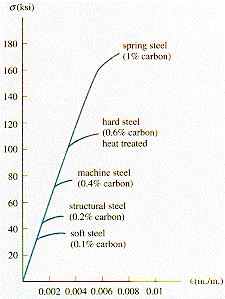 |
 |
 |
 |
 |
 |
 |
 |
 |
 |
 |
 |
 |
 |
|
|
|
|
|
|
|
|
|
|
|
|
|
|
|
|
|
|
|
|
|
|
|
|
|
|
|
|
|
|
|
|
Mechanical
Properties |
|
|
|
|
|
|
|
|
|
|
|
|
|
|
|
|
|
|
|
|
|
|
|
|
|
|
|
|
|
|
|
|
|
|
|
|
|
·
Substituting
the values for σ, ε, and
m, into Hooke's law and collecting (material) and {design} parameters gives:
[F/m]
= (E/ρ
){δL/L2} |
|
|
|
|
|
|
|
|
|
|
|
|
|
|
|
|
|
·
The
lightest strut for a given deformation will have the largest value of (E/ρ)
and materials can be selected for a task using this criterion.
· Although
alloying does not alter Young's modulus, it does change the yield
stress, as shown opposite.
· Alloys
may extend the useful elastic range, however, alloying may also reduce
the ductile range of material response and reduce safety margins.
· Material
selection based on tensile loading and the yield stress criterion identifies
the lightest structure by maximizing (σy/ρ).
|
|
|
|
|
|
|
|
|
|
|
|
 |
|
|
|
|
|
|
|
|
|
|
|
|
From:
Hibbler, "Mechanics of Materials," MacMillan (1994) |
|
|
|
|
